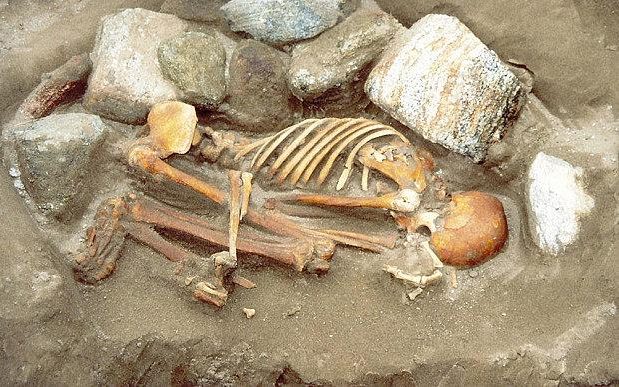The Telegraph, “Half of Western European men descended from one Bronze Age ‘king” 25 April 2016:
A bronze age burial South Uist, in the Outer Hebridean Western Isles

Mass graves were replaced by individual burials for the elite in the Bronze Age showing a shift in social structure Credit: PA
Half of Western European men are descended from one Bronze Age ‘king’ who sired a dynasty of elite nobles which spread throughout Europe, a new study has shown.
The monarch, who lived around 4,000 years ago, is likely to have been one of the earliest chieftains to take power in the continent.
He was part of a new order which emerged in Europe following the Stone Age, sweeping away the previous egalitarian Neolithic period and replacing it with hierarchical societies which were ruled by a powerful elite.
It is likely his power stemmed from advances in technology such as metal working and wheeled transport which enabled organised warfare for the first time.
Although it is not known who he was, or where he lived, scientists say he must have existed because of genetic variation in today’s European populations.
Dr Chris Tyler-Smith, from the Wellcome Trust Sanger Institute, said: “One of the most novel and exciting things we have found in the study is the extraordinary explosion in numbers of males at specific times.
“In Europe there was huge population expansion in just a few generations. Genetics can’t tell us why it happened but we know that a tiny number of elite males were controlling reproduction and dominating the population.
“Half of the Western European population is descended from just one man. We can only speculate as to what happened. The best explanation is that they may have resulted from advances in technology that could be controlled by small groups of men.
“Wheeled transport, metal working and organised warfare are all candidate explanations that can now be investigated further.”
Studying the genomes of people across the world can show how populations have spread Credit: Alamy
The study analysed sequence differences between the Y chromosomes of more than 1200 men from 26 populations around the world using data generated by the 1000 Genomes Project.
The Y chromosome is only passed from father to son and so is wholly linked to male characteristics and behaviours. Mutations reveal which are related to each other and how far apart they are genetically so that researchers can build a family tree.
Dr Yali Xue, lead author from the Wellcome Trust Sanger Institute, explained: “This pattern tells us that there was an explosive increase in the number of men carrying a certain type of Y chromosome, within just a few generations.
“We only observed this phenomenon in males, and only in a few groups of men.”
The team used the data to build a tree of the 1200 Y chromosomes. It shows how they are all related to one another. As expected, they all descend from a single man who lived approximately 190,000 years ago.
The most intriguing and novel finding was that some parts of the tree were more like a bush than a tree, with many branches originating at the same point.
The earliest explosive increases of male numbers occurred 50,000–55,000 years ago, across Asia and Europe, and 15,000 years ago in the Americas.
There were also later expansions in sub-Saharan Africa, Western Europe, South Asia and East Asia, at times between 4,000 and 8,000 years ago. The team believes the earlier population increases resulted from the first peopling by modern humans of vast continents, where plenty of resources were available.
Dr David Poznik, from Stanford University, California, first author on the paper, said: “We identified more than 60,000 positions where one DNA letter was replaced by another in a man with modern descendants, and we discovered thousands of more complex DNA variants.
“These data constitute a rich and publicly available resource for further genealogical, historical and forensic studies.”
The research was published in the journal Nature Genetics.
As European peoples we are stakeholders in a varied but identifiable genetic heritage: Participation in curating and defending these genetics is one of the most radical, verifiable and essential grounds upon which we can coordinate our fight for our interests..

Posted by common European ancestry cited on Tue, 03 May 2016 19:05 | #